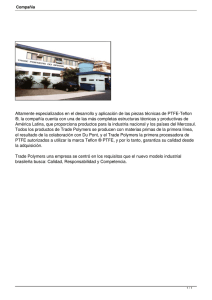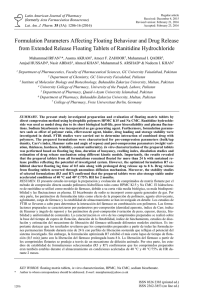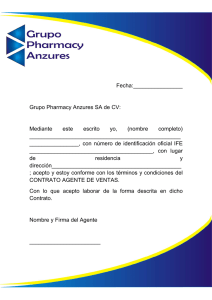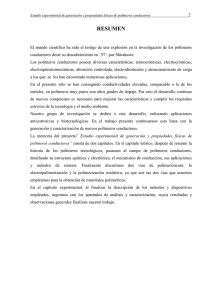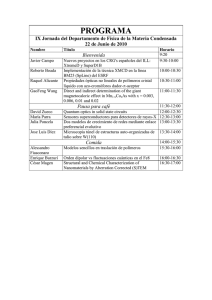1533-1539 Qureshi LAJP 3704:Qureshi
Anuncio
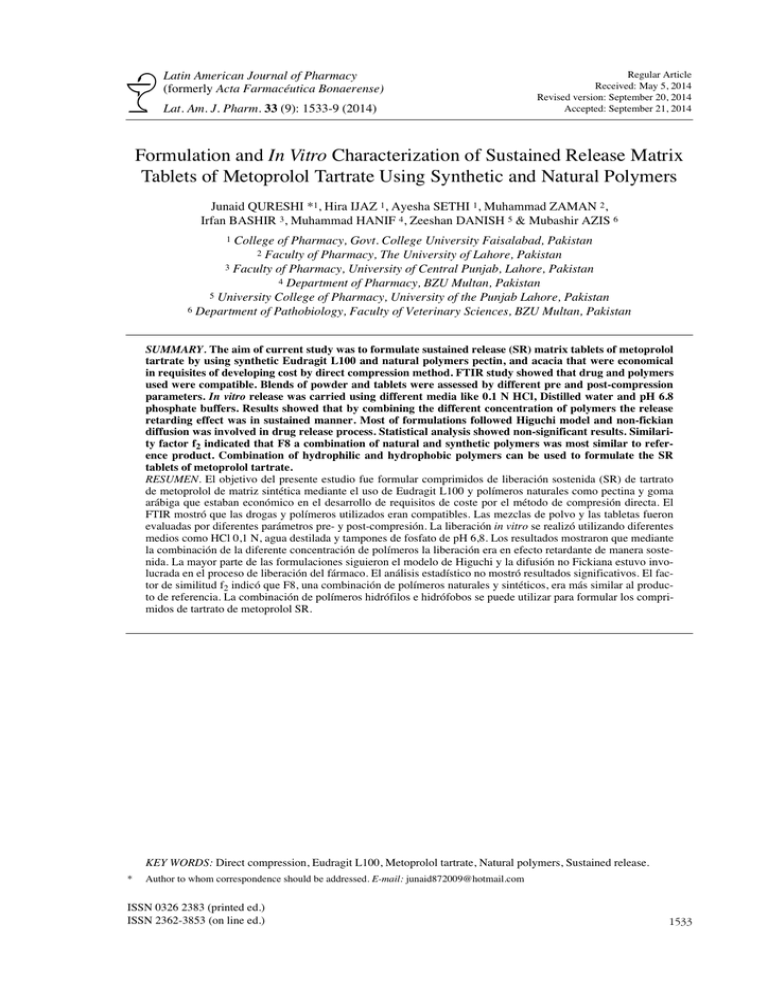
Latin American Journal of Pharmacy (formerly Acta Farmacéutica Bonaerense) Lat. Am. J. Pharm. 33 (9): 1533-9 (2014) Regular Article Received: May 5, 2014 Revised version: September 20, 2014 Accepted: September 21, 2014 Formulation and In Vitro Characterization of Sustained Release Matrix Tablets of Metoprolol Tartrate Using Synthetic and Natural Polymers Junaid QURESHI *1, Hira IJAZ 1, Ayesha SETHI 1, Muhammad ZAMAN 2, Irfan BASHIR 3, Muhammad HANIF 4, Zeeshan DANISH 5 & Mubashir AZIS 6 College of Pharmacy, Govt. College University Faisalabad, Pakistan 2 Faculty of Pharmacy, The University of Lahore, Pakistan 3 Faculty of Pharmacy, University of Central Punjab, Lahore, Pakistan 4 Department of Pharmacy, BZU Multan, Pakistan 5 University College of Pharmacy, University of the Punjab Lahore, Pakistan 6 Department of Pathobiology, Faculty of Veterinary Sciences, BZU Multan, Pakistan 1 SUMMARY. The aim of current study was to formulate sustained release (SR) matrix tablets of metoprolol tartrate by using synthetic Eudragit L100 and natural polymers pectin, and acacia that were economical in requisites of developing cost by direct compression method. FTIR study showed that drug and polymers used were compatible. Blends of powder and tablets were assessed by different pre and post-compression parameters. In vitro release was carried using different media like 0.1 N HCl, Distilled water and pH 6.8 phosphate buffers. Results showed that by combining the different concentration of polymers the release retarding effect was in sustained manner. Most of formulations followed Higuchi model and non-fickian diffusion was involved in drug release process. Statistical analysis showed non-significant results. Similarity factor f2 indicated that F8 a combination of natural and synthetic polymers was most similar to reference product. Combination of hydrophilic and hydrophobic polymers can be used to formulate the SR tablets of metoprolol tartrate. RESUMEN. El objetivo del presente estudio fue formular comprimidos de liberación sostenida (SR) de tartrato de metoprolol de matriz sintética mediante el uso de Eudragit L100 y polímeros naturales como pectina y goma arábiga que estaban económico en el desarrollo de requisitos de coste por el método de compresión directa. El FTIR mostró que las drogas y polímeros utilizados eran compatibles. Las mezclas de polvo y las tabletas fueron evaluadas por diferentes parámetros pre- y post-compresión. La liberación in vitro se realizó utilizando diferentes medios como HCl 0,1 N, agua destilada y tampones de fosfato de pH 6,8. Los resultados mostraron que mediante la combinación de la diferente concentración de polímeros la liberación era en efecto retardante de manera sostenida. La mayor parte de las formulaciones siguieron el modelo de Higuchi y la difusión no Fickiana estuvo involucrada en el proceso de liberación del fármaco. El análisis estadístico no mostró resultados significativos. El factor de similitud f2 indicó que F8, una combinación de polímeros naturales y sintéticos, era más similar al producto de referencia. La combinación de polímeros hidrófilos e hidrófobos se puede utilizar para formular los comprimidos de tartrato de metoprolol SR. KEY WORDS: Direct compression, Eudragit L100, Metoprolol tartrate, Natural polymers, Sustained release. * Author to whom correspondence should be addressed. E-mail: [email protected] ISSN 0326 2383 (printed ed.) ISSN 2362-3853 (on line ed.) 1533
